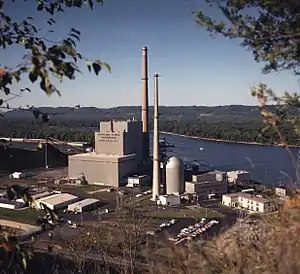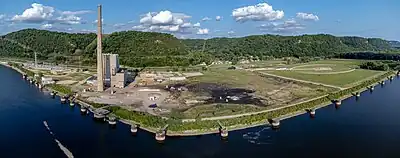| La Crosse Boiling Water Reactor | |
|---|---|
 La Crosse Boiling Water Reactor. | |
Location of La Crosse Boiling Water Reactor within Wisconsin | |
| Country | United States |
| Location | Genoa, Wisconsin |
| Coordinates | 43°33′36″N 91°13′53″W / 43.5601°N 91.2315°W |
| Status | Decommissioned |
| Construction began | March 1, 1963[1] |
| Commission date | November 7, 1969[1] |
| Decommission date | April 30, 1987[1] |
| Operator(s) | Dairyland Power Cooperative |
| Nuclear power station | |
| Reactor type | BWR[1] |
| Power generation | |
| Units decommissioned | 50 MWe[1] |
| Nameplate capacity | 50 MWe[1] |
| External links | |
| Website | www |
| Commons | Related media on Commons |
La Crosse Boiling Water Reactor (LACBWR) was a boiling water reactor (BWR) nuclear power plant located near La Crosse, Wisconsin in the small village of Genoa, in Vernon County, Wisconsin, approximately 17 miles south of La Crosse along the Mississippi River. It was located directly adjacent to the coal-fired Genoa Station #3. The site is owned and was operated by Dairyland Power Cooperative (Dairyland). Although the reactor has been demolished and decommissioned, spent nuclear fuel is still stored at the location.
LACBWR was built from 1963 to 1967 as part of a federal project to demonstrate the viability of peacetime nuclear power. It was designed and built by Allis-Chalmers and funded in part by the Atomic Energy Commission (AEC) in cooperation with Dairyland Power Cooperative. The reactor began commercial operation in 1969 and reached full capacity in 1971.[1][2] LACBWR had a 50 MW electrical output from a forced-circulation, direct-cycle boiling water reactor as its heat source.[3] In 1973 the reactor and fuel were transferred in full to Dairyland Power.
Decommissioning and waste disposal
In April 1987, LACBWR was shut down because the small size of the plant made it no longer economically viable. It was placed in SAFSTOR August 7, 1991. The reactor pressure vessel was removed in May 2007 and shipped to Chem-Nuclear's Barnwell, South Carolina Low-Level Radioactive Waste (LLRW) disposal facility. The shipment weighed approximately 310 tons and required a specially designed rail car.
In 2012, spent nuclear fuel from the reactor was sealed into a dry cask storage installation located immediately south of the Genoa Generating Station.[4] Spent reactor fuel continues to be stored on site pending the creation of a national radioactive waste disposal facility such as Yucca Mountain.[5]
In 2016, Dairyland transferred control of the inactive reactor facility to LaCrosseSolutions, a subsidiary of Utah-based EnergySolutions, for the purpose of demolition and decommissioning.[6]
In February 2017, workers spilled about 400 gallons of radioactive wastewater into the Mississippi River after leaving a hose and sump pump in a tank overnight.[7] The wastewater contained Caesium-137 at concentrations greater than allowed under federal regulation for discharge; however, the resulting radiation was below levels considered harmful to human health.[8] In another incident, routine tests from December 2017 to August 2018 detected elevated levels of tritium in groundwater at the site. The tritium was traced to condensation around a vent installed during demolition of the facility and the leak was mitigated before spreading to the Mississippi River.[9]
In 2019, EnergySolutions announced that it had completed the physical demolition of the reactor.[10] The decommissioning of the site was delayed through 2022 pending the evaluation of survey data.[11][12] In February 2023, the Nuclear Regulatory Commission approved the final decommissioning of the site. This returned the area to unrestricted use, with the exception of the independent spent fuel storage installation maintained by Dairyland Power.[13][14]
See also
References
- 1 2 3 4 5 6 7 "Lacrosse Reactor Details". IAEA. 2022-03-15. Retrieved 2022-03-16.
- ↑ Driscoll, David (Autumn 2001). "Slow Boil: The Story of Wisconsin's First Nuclear Reactor". Wisconsin Magazine of History. 85 (1): 34–45. Retrieved 16 March 2022.
- ↑ "La Crosse Boiling Water Reactor". Nuclear Regulatory Commission. Retrieved 2013-04-14.
- ↑ Hubbuch, Chris (15 July 2012). "A nuclear option: After 25 years, Genoa reactor's waste gets new home". La Crosse Tribune. Retrieved 16 March 2022.
- ↑ Hubbuch, Chris (29 October 2018). "As Trump wavers on Yucca Mountain, nuclear waste, costs mount". La Crosse Tribune. Retrieved 16 March 2022.
- ↑ "NRC Approves Transfer of Operational Control of LaCrosse NPP to EnergySolutions for Final D&D". GlobeNewswire. 2 June 2016. Retrieved 15 March 2022.
- ↑ Hubbuch, Chris (26 March 2018). "NRC: Company dismantling Genoa nuclear plant spilled tainted water into Mississippi River". La Crosse Tribune. Retrieved 15 March 2022.
- ↑ "Officials: Spill at Wisconsin nuclear plant not health risk". AP NEWS. 27 March 2018. Retrieved 15 March 2022.
- ↑ Hubbuch, Chris (28 January 2019). "Report: Source of radioactive groundwater located; no contamination of drinking water, Mississippi River". Wisconsin State Journal. Retrieved 15 March 2022.
- ↑ "EnergySolutions Completes Work at La Crosse Boiling Water Reactor (LACBWR) Decommissioning Project". GlobeNewswire. 12 November 2019. Retrieved 15 March 2022.
- ↑ Hubbuch, Chris (27 September 2021). "Project delays plague company seeking to buy Kewaunee nuclear plant". Wisconsin State Journal. Retrieved 15 March 2022.
- ↑ "US NRC delays release of La Crosse and Zion sites for unrestricted use - Nuclear Engineering International". Nuclear Engineering International. 20 September 2021. Retrieved 15 March 2022.
- ↑ "La Crosse BWR site released for unrestricted use". www.ans.org. Radwaste Solutions. Retrieved 24 August 2023.
- ↑ "La Crosse Boiling Water Reactor". NRC Web. Nuclear Regulatory Commission. Retrieved 24 August 2023.
External links
- NukeWorker Archived 2007-03-10 at the Wayback Machine
- Dairyland Power Cooperative LACBWR page

